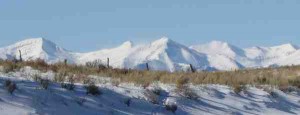Brief by Allen Best
Environment – February 2008 – Colorado Central Magazine
Various lakes and reservoirs in the San Juan Mountains have elevated levels of mercury. People are advised to limit how many fish they eat from Vallecito, McPhee and other lakes and reservoirs because of the high mercury levels.
The question is where the mercury is coming from. Sometimes mercury is found naturally in the environment.
Then again, it is also found in the emissions of power plants. Specifically suspect, but lacking any specific fingerprints, is the nearby Four Corners power plant.
Preliminary results of samples taken at Molas Divide, located between Silverton and Durango, indicate high concentrations of mercury in snow and rain.
The samples were gathered from April to November by the Mountain Studies Institute and showed 3 to 29 nanograms per liter. Concentrations of less than 6 are considered low, and levels above around 12 are high.
These findings, says the institute, are consistent with elevated concentrations often recorded at Mesa Verde National Park since monitoring began in 2002.
Does this mean that the mercury is from emissions by the Four Corners coal-fired power plant or other power plants? A newsletter issued by the institute for December offers no theories.


